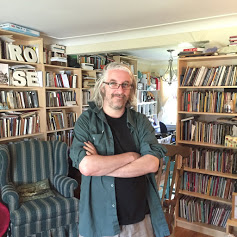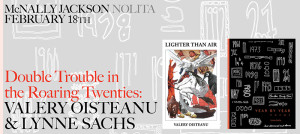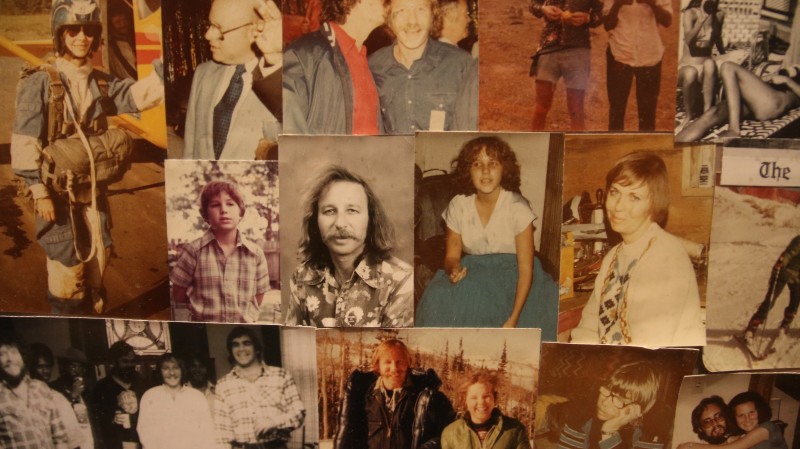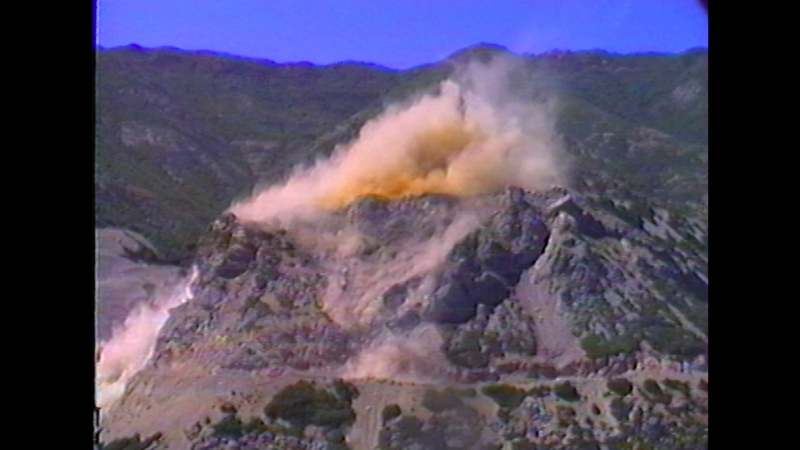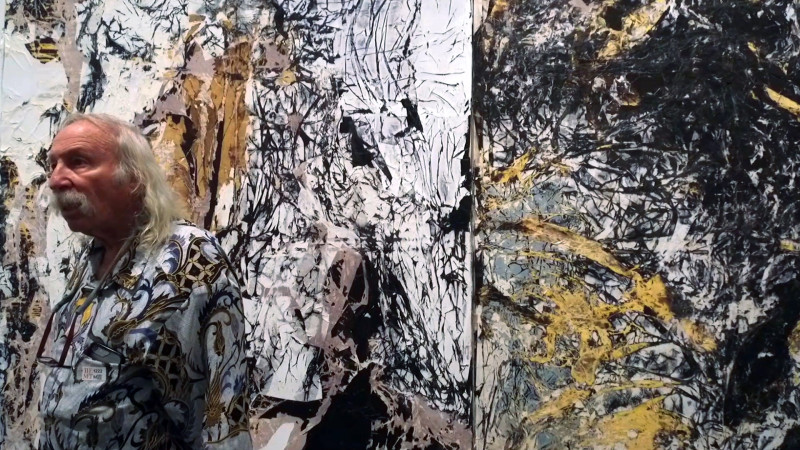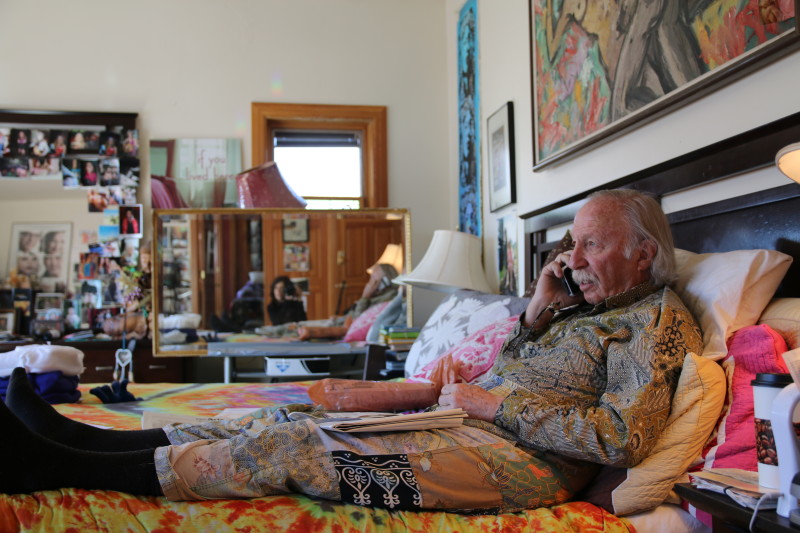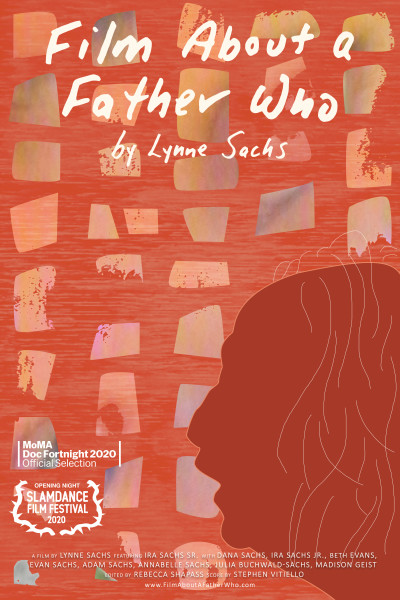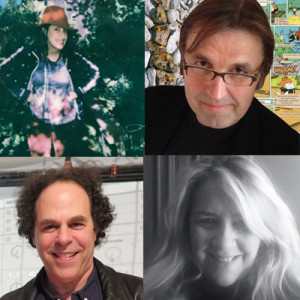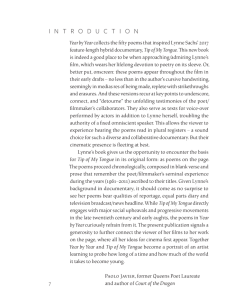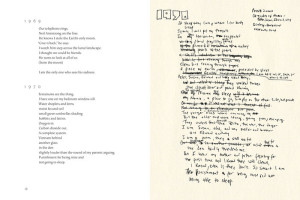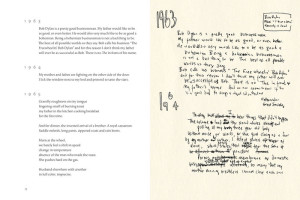02/27/2020
Rob McLennan’s Blog
12 or 20 (second series) questions with Lynne Sachs
By Rob McLennan
https://robmclennan.blogspot.com/2020/02/12-or-20-second-series-questions-with_27.html
Lynne Sachs makes films and writes poems that explore the intricate relationship between personal observations and broader historical experiences. Her work embraces hybrid form and combines memoir with experimental, documentary, and fictional modes. In recent years, she has expanded her practice to include live performance with moving image. Lynne was first exposed to poetry by her great aunt as a child in Memphis, Tennessee. Soon she was frequenting workshops at the local library and getting a chance to learn from poets like Gwendolyn Brooks and Ethridge Knight. As an active member of Brown University’s undergraduate poetry community, she shared her early poems with fellow poet Stacy Doris. Lynne later discovered her love of filmmaking while living in San Francisco where she worked with artists Craig Baldwin, Bruce Conner, Barbara Hammer, Carolee Schneeman, and Trinh T. Minh-ha. Lynne has made thirty-five films which have screened at the New York Film Festival, the Sundance Film Festival, the Museum of Modern Art, the Whitney Museum of American Art, the Walker Art Center, and the Wexner Center for the Arts. Festivals in Buenos Aires, Beijing and Havana have presented retrospectives of her work. Lynne received a 2014 Guggenheim Fellowship. In early 2020, her newest movie, Film About a Father Who, will premiere on opening night at the Slamdance Film Festival and in NYC at the Museum of Modern Art. Lynne lives in Brooklyn. Year by Year Poems is her first book of poetry.
1 – How did your first book change your life? How does your most recent work compare to your previous? How does it feel different?Writing YEAR BY YEAR POEMS did not just change my life, it was my life. When I turned 50, I decided to reconnect with every year of my life, so far, by writing a poem that explores the relationship I had had with something beyond my control, outside my domestic universe. The personal confronts the public, and vice-versa. Writing these poems forced me to carve out precise distillations of these moments in my time and our shared time.
2 – How did you come to filmmaking first, as opposed to, say, poetry, fiction or non-fiction?
I have been writing poetry since I was a child and filmmaking is actually an extension of this desire to process my bewilderment and occasional understanding of the world that spins around me. The personal, experimental, essayistic, documentary approaches I bring to my filmmaking are extensions of the thinking involved in writing a poem.
3 – How long does it take to start any particular writing project? Does your writing initially come quickly, or is it a slow process? Do first drafts appear looking close to their final shape, or does your work come out of copious notes?
I adore first drafts and for this reason I try to write my poems by hand, with a pen on paper. I return to them like an archeologist, relishing every gesture that I see on the page. With this in mind, I included many of my first drafts – as images almost – in YEAR BY YEAR POEMS. So far, readers have generally appreciated seeing these visualizations of the process of writing, moving back-and-forth between the inchoate first draft to the finished, edited, typed version. My mother was the only person who thought some of the poems were better and more fleshed-out in the original drafts. I thought this was apt, since her perspective on my life is probably the most complete.
4 – Where does a poem, work of prose or film-script usually begin for you? Are you an author of short pieces that end up combining into a larger project, or are you working on a “book” from the very beginning?
Each poem in YEAR BY YEAR POEMS begins with a year. In fact, I gave myself the pleasure of inventing a new graphic font for each of these 50 years, and these designs/ doodles became the cover of the book. Limitations or constraints on the writing of a poem actually allow me to work in a more expansive way. I feel less overwhelmed by the daunting challenge of trying to say something. In terms of my filmmaking, I have made 35 films, the shortest being 3 minutes and the longest 83. I just completed FILM ABOUT A FATHER WHO which is 74 minutes and will premiere next month as the opening night film at Slamdance Film Festival in Park City and then at the Museum of Modern Art in New York City in February. Believe it or not, I started this film in 1984 and just finished it. The only way I could find its structure was to create many short films and then to find search for compelling transitions.
5 – Are public readings part of or counter to your creative process? Are you the sort of writer who enjoys doing readings?
I have finally discovered the joy of reading from my book in front of an audience. I have never ever been an actor so it did not really appeal to me before. Now, when I am reading from my own book, I feel deeply connected to the listeners in the room. It is so much fun to watch people responding. I have recently read or will read at Berl’s Poetry Bookshop, Topos Books, McNally Jackson Bookstore, KGB Lit Bar, Court Tree Gallery, Penn Book Center, and Museum of Modern Art Buenos Aires (with a translator). I will be reading from my book and showing my films at the main branch of the San Francisco Public Library for National Poetry Month in April, 2020.
6 – Do you have any theoretical concerns behind your writing? What kinds of questions are you trying to answer with your work? What do you even think the current questions are?
I think my deepest concerns stem from my visceral devotion to feminism.
7 – What do you see the current role of the writer being in larger culture? Does s/he even have one? What do you think the role of the writer should be?
A writer should stir of up thought and encourage a fascination with language. Writers who have found a place in the community should also encourage others with less experience through workshops that bring in people who have not yet named themselves as “writers.”
8 – Do you find the process of working with an outside editor difficult or essential (or both)?
I absolutely adore working with an editor, both people I know and trust to be honest and kind and people who care only about one thing – making the text better. In writing my first book of poems, I worked with my Tender Buttons Press editrix Lee Ann Brown who had some uncannily astute suggestions that included line breaks, word choices, finding clarity, carving way too much explication and everything in between. Working with her as well as my poet friends Michael Ruby and Michele Somerville was a gift. In addition, very early on, I actually hired a graduate student in creative writing to meet with me just a few times. She would read the poems with such distance and objectivity. It was refreshing, and I didn’t feel guilty asking her to explain what she thought since I was paying her.
9 – What is the best piece of advice you’ve heard (not necessarily given to you directly)?
Read your poems out loud to yourself. Listen to the rhythm and feel it in your body.
10 – How easy has it been for you to move between genres (poetry to fiction to filmmaking to multimedia)? What do you see as the appeal?
Oh, you really ask such insightful questions. What do I call myself? Am I filmmaker who writes poems? Can I be more than one thing? Can I just be an artist? Can I change according to my surroundings? I think our culture is actually becoming more open to these permutations. Patti Smith (musician and author) and Tony Kushner(playwright, screenwriter and children’s book writer) are two of my heroes in this respect. Finding visual or textual distillations is at the foundation of both my writing and my filmmaking. In neither situation do I ever call myself a storyteller.
11 – What kind of writing routine do you tend to keep, or do you even have one? How does a typical day (for you) begin?
On a writing day, I do what so many other writers do. I am not particularly ingenious in any way. I go out to a café, buy a cup of tea (preferably in a teapot) and begin to write. As long as the music is good and people are not talking on their cell phones, I am happy.
12 – When your writing gets stalled, where do you turn or return for (for lack of a better word) inspiration?
When my writing feels hampered by the clutter of my life, I set limits. I frame my ambition by a constraint, like only thinking about one particular conceit or finding my way to the bottom of the page. I try, though I am rarely successful, not to read what I have written as a reader but rather as co-conspirator with absolutely no taste. Taste is dangerous. So is the internet, so I try to reject that in any way possible.
13 – What fragrance reminds you of home?
About twenty-five years ago, I was visiting the Glen Canyon Dam at Lake Powell in Utah. It’s a very strange and other-wordly lake, mostly because it is artificial and built by recreation lovers who didn’t mind filling in a canyon in a naturally arid landscape to create a place for water-skiers. My sister Dana Sachs and I were together in the elevator descending to its lowest level. When the elevator doors opened, we immediately turned to one another and remarked that this dark, intimidating, cement space smelled like our grandparents’ home in Memphis, Tennessee, a place we had not been inside since we were children. Recognizing that “fragrance” concretized our sensory bond as sisters who were carrying so many of the same memories.
14 – David W. McFadden once said that books come from books, but are there any other forms that influence your work, whether nature, music, science or visual art?
I am very influenced by the conceptually rigorous approaches of Vito Acconci, Ana Medietta, Carolee Schneemann, Adrian Piper, and Hans Haacke.
15 – What other writers or writings are important for your work, or simply your life outside of your work?
Last week, I finished reading James Joyce’s Ulysses. It took me six months and the experience was fantastic and awful, ultimately ending with ecstasy. The experience was convulsive and exasperating. I was transformed in a way that was truly extraordinary. I am a different person now that I have read Molly Bloom’s treatise on her body in the book’s last chapter; her one-sentence no-punctuation 25,000 word spin through the sensual made me reel and dream and sing. I would add to that a few other writers who come to mind today: filmmaker and poet Trinh T. Minh-ha, author and scholar Tera W. Hunter, author Claire Messud, poet Lee Ann Brown, and poet Katy Bohinc.
16 – What would you like to do that you haven’t yet done?
Canadian film director François Gerard completed his highly successful film Thirty-TwoShort Films About Glenn Gould in 1993. In an interview, a reporter asked him what he planned to do next. His response was that he planned to donothing. Doing nothing for an artist can be transformative. I envy people who claim to be bored. I do not have ahorror vacui. I search for emptiness and find a sense of tranquility. Ultimately, it is very productive.
17 – If you could pick any other occupation to attempt, what would it be? Or, alternately, what do you think you would have ended up doing had you not been a writer?
I did consider being a human rights attorney, a pediatrician or an anthropologist. I also wish I could cook well, though I don’t aim to be a chef.
18 – What made you write, as opposed to doing something else?Writing gives me so much oxygen. When you write, you feel like you added one minute to the 1440 minutes in a day.
19 – What was the last great book you read? What was the last great film?
As written above, I recently completed Ulysses, but you know that is a great one. I also was very taken with Maggie Nelson’s The Argonauts which showed me how to weave together intimate personal writing with more theoretical investigations. I return over and over and over again to filmmaker Ken Jacobs’ Star Spangled To Death, which is his opus film that he bravely refuses to complete.
20 – What are you currently working on?
Oh Ida: The Fluid Time Travels of a Radical Spirit, an experimental, sci-fi essay film that will trace the erasure and recent emergence (in the form of monuments) of the story of activist and journalist Ida B. Wells-Barnett who spent her early years in my hometown of Memphis, Tennessee and committed her life to nurturing a spirit of liberation in the face of resounding racial violence. I am making this film with author Tera Hunter and a few weeks ago we started shooting. It’s a blissful, intense collaboration.

